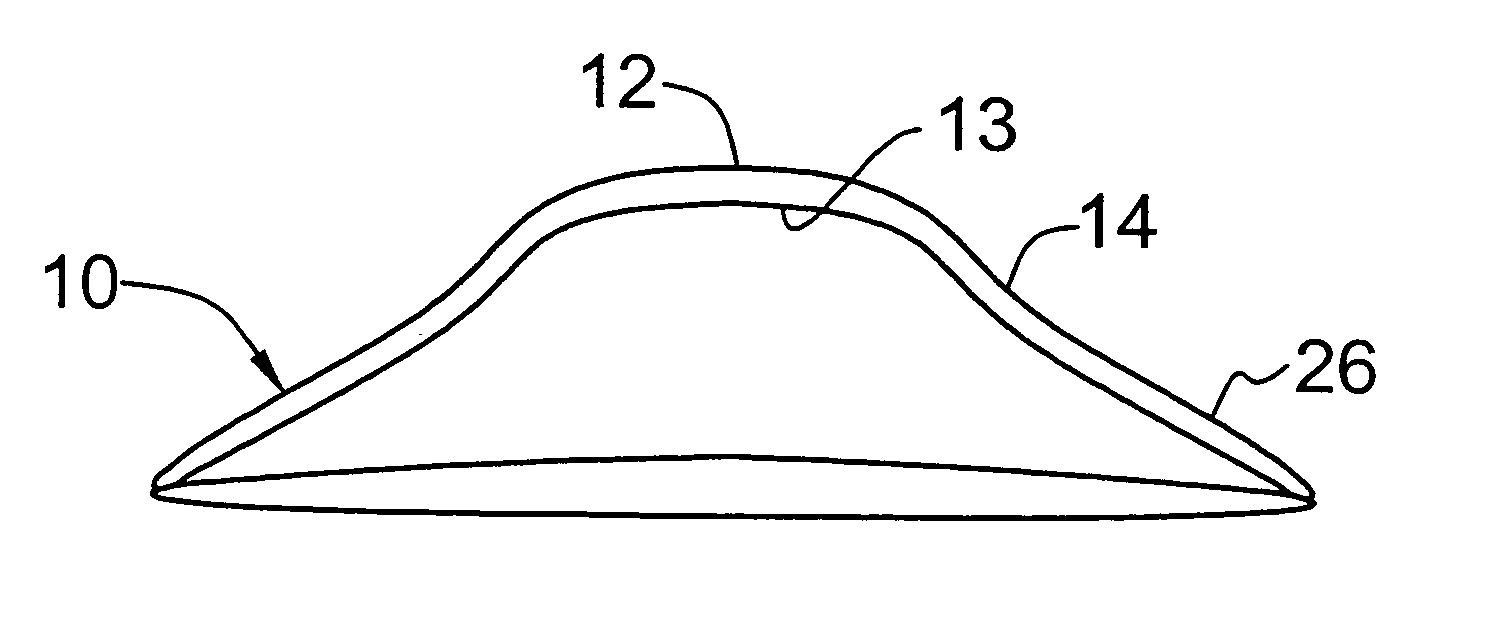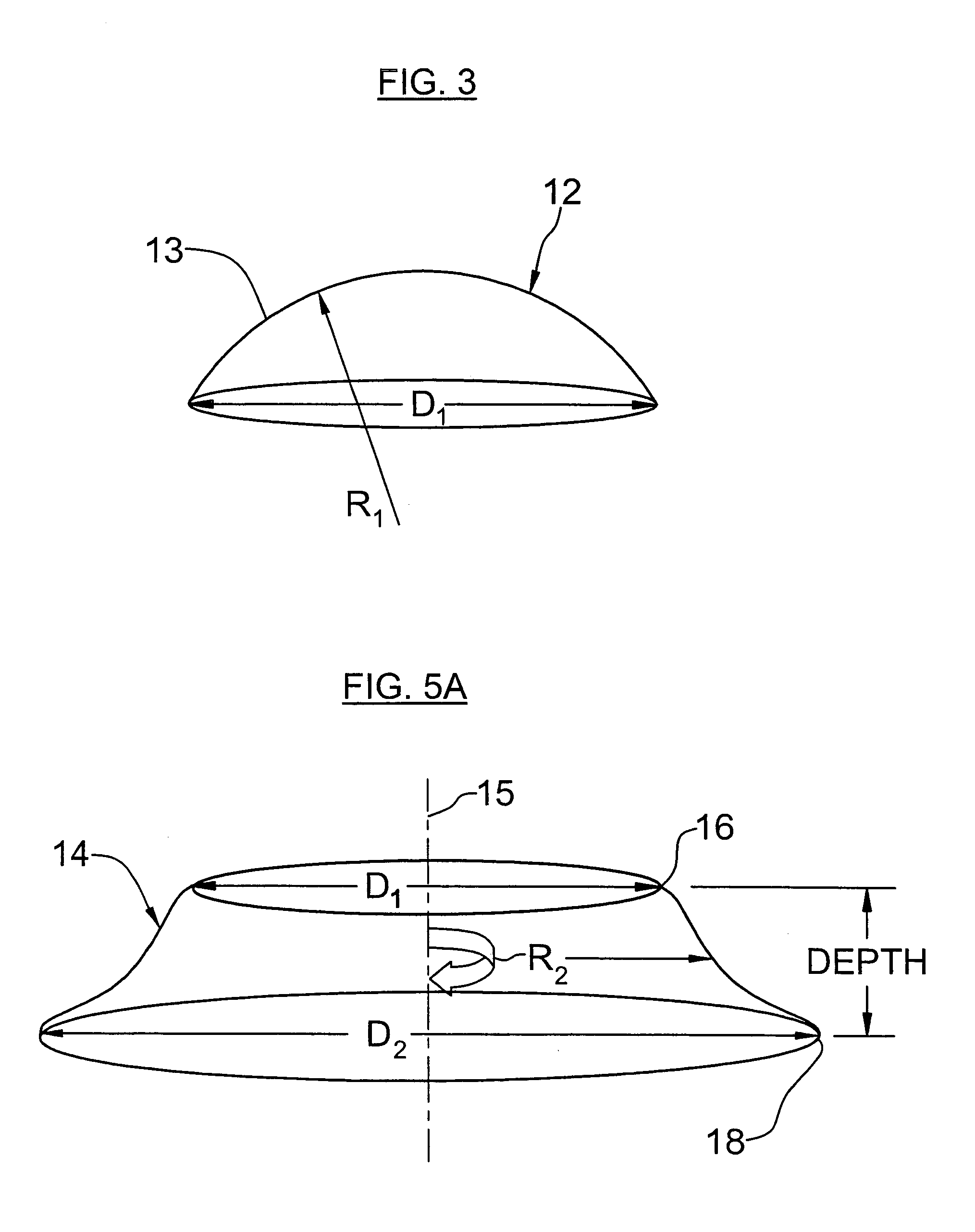Contact lens and methods of manufacture and fitting such lenses and computer program product
a technology of contact lenses and computer programs, applied in the field of contact lenses and methods of manufacture, can solve the problems of increasing the cost of general use of such procedures, increasing the cost of such procedures, and affecting so as to improve the ability of fitters, facilitate design or correction, and facilitate the effect of formation
- Summary
- Abstract
- Description
- Claims
- Application Information
AI Technical Summary
Benefits of technology
Problems solved by technology
Method used
Image
Examples
example 1
[0065]This example is based upon a patient having a prescription as follows:
1. 44.50×46.00@180, Rx−4.00−0.75×180, e=0.5, HVID 11.6
Based upon the prescription of patient 1 above, a lens designer would select the power of the lens to correct the patient to a desired degree. In this example, with reference to FIG. 9, the lens / cornea power difference wanted for patient 1 is selected as −4.5 diopters as indicated at 200. The power difference selected is slightly more than the degree of correction required for the patient, to allow substantial correction of visual acuity over a longer period of time after reshaping of the cornea using the lens according to the invention. Patient 1 also has a fairly high astigmatism of 0.75, and the ellipticity of the cornea is 0.5 as shown at 202. Patient 1 has an HVID of 11.6, as noted at 204, and based upon this HVID, the diameter of the lens which is recommended is 10.6 mm as indicated at 206, being 1 mm less than the measured HVID. The selected diamet...
example 2
[0066]For patient 2, having a prescription as follows:
42.00×44.00@165, Rx−3.50−1.00×160, e=0.6, HVID 11.4
With patient 2, a relatively high refractive error along with high astigmatism is noted, which again will lead the lens designer to increase the value of the ellipticity of the cornea as shown at 230 in FIG. 14. Due to the high astigmatism, it is desired to have a thicker center in the lens, which again is easily accommodated by varying the delta r for the first junction between the base curve and the sigmoidal curve as shown at 232. Other aspects of the particular lens design for patient 2 are determined in a manner similar to that described with reference to patient 1 in Example 1. Particular values for the variables, including base curve, lens diameter, angle of the peripheral zone as well as depth of the sigmoidal curve are shown in FIG. 14, with the relationship between the zones shown graphically in FIG. 15. The relatively thick center and thinner edge portion in this lens ...
example 3
[0067]For patient 3 having a prescription as follows:
46.50×46.50@180, Rx−6.00−0.75×90, e=0.4, HVID 11.2
With reference to FIGS. 19–23, a lens design according to the present invention for patient 3 is shown. Selecting parameters of the base curve, base diameter, angle of peripheral zone as well as depth of the sigmoidal curve are selected in a manner similar to that previously described, providing a first indication of fit to the lens designer. For patient 3 using a value of 3.0 mm as the radial distance from the lens center to the first junction, which may in general be held uniform, produced a relatively large void space adjacent the base curve at the first junction. The lens designer therefore has the flexibility to reduce or narrow the optical zone, as indicated by the use of 2.5 mm at 210 and increases the width of the sigmoidal curve indicated at 212 as 2.0. The relationship of the zones relative to one another and the cornea are shown in FIGS. 20–23, wherein the void space adj...
PUM
 Login to View More
Login to View More Abstract
Description
Claims
Application Information
 Login to View More
Login to View More - R&D
- Intellectual Property
- Life Sciences
- Materials
- Tech Scout
- Unparalleled Data Quality
- Higher Quality Content
- 60% Fewer Hallucinations
Browse by: Latest US Patents, China's latest patents, Technical Efficacy Thesaurus, Application Domain, Technology Topic, Popular Technical Reports.
© 2025 PatSnap. All rights reserved.Legal|Privacy policy|Modern Slavery Act Transparency Statement|Sitemap|About US| Contact US: help@patsnap.com



